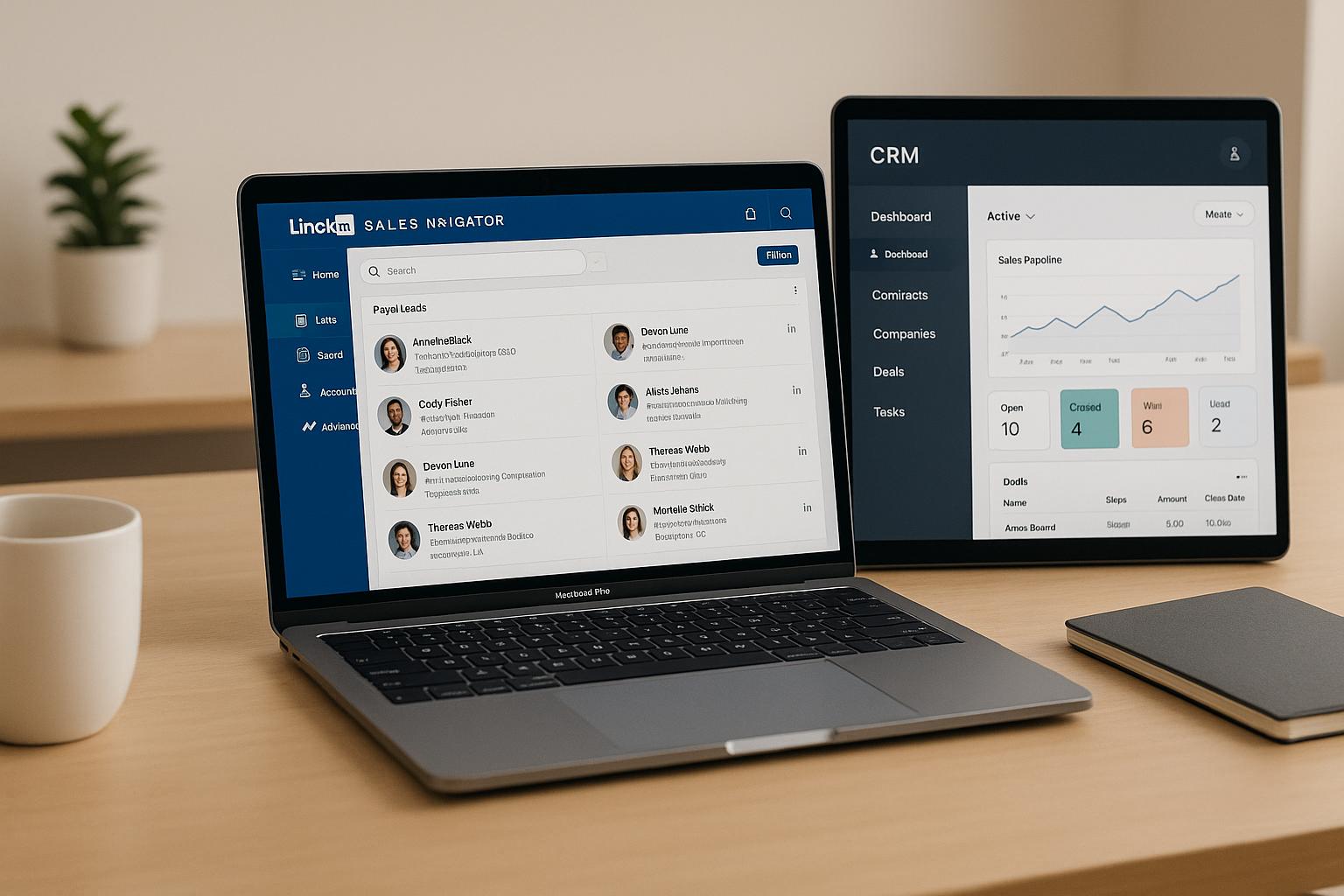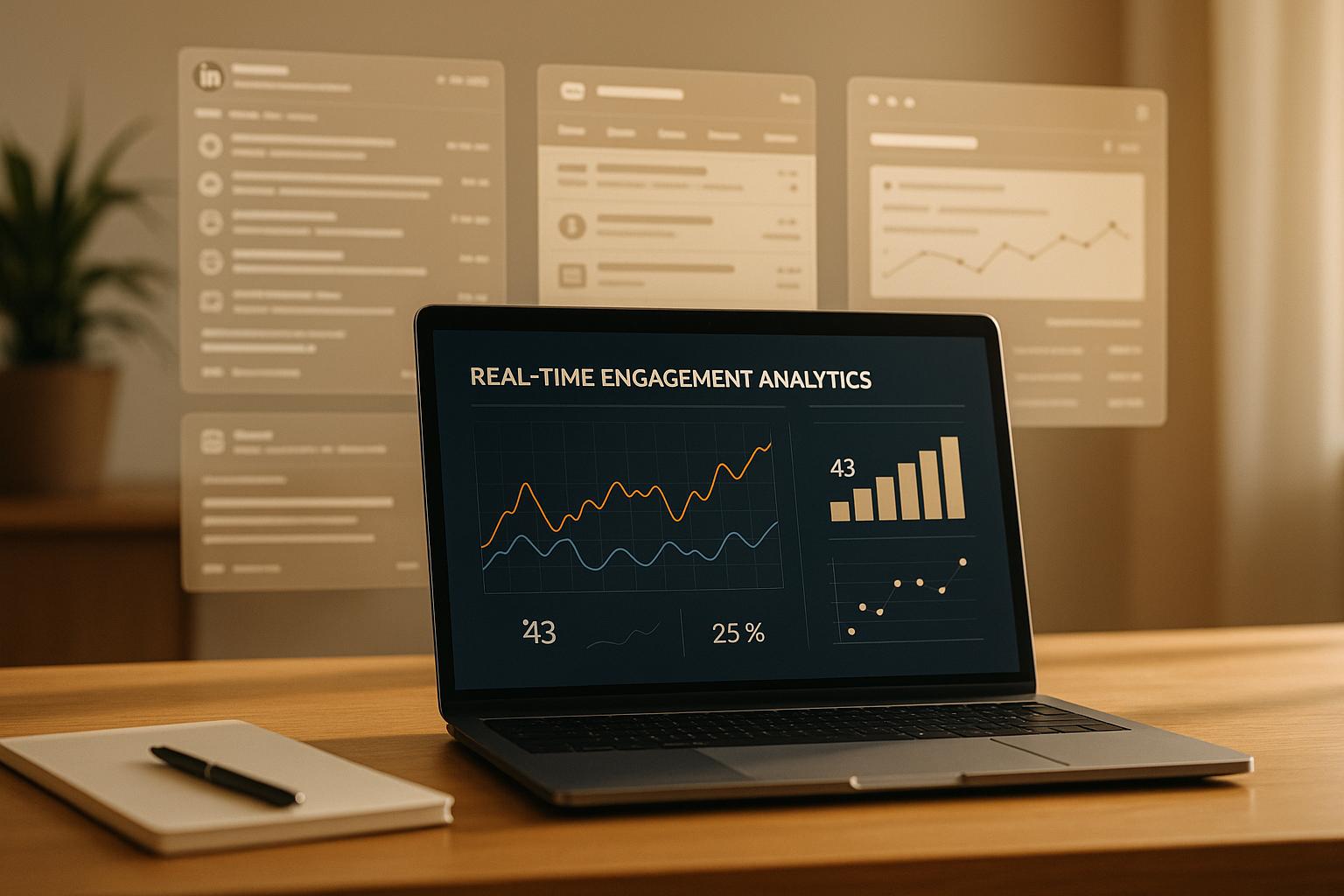
.avif)
Julien Gadea
Julien Gadea specializes in AI prospecting solutions for business growth. Empowering businesses to connect with their audience with SalesMind AI tools that automate your sales funnel, starting from lead generation.
Choosing between LinkedIn Sales Navigator and CRM integration tools comes down to your sales workflow needs. Here’s the gist:
- LinkedIn Sales Navigator: A premium LinkedIn tool offering advanced prospecting, real-time updates, and CRM syncing for LinkedIn-based workflows. Best for teams focusing heavily on LinkedIn engagement.
- CRM Integration Tools: Connect LinkedIn data directly to CRMs like Salesforce or HubSpot, enabling centralized lead management and automated workflows. Ideal for teams prioritizing CRM-based operations.
Key differences:
- Sales Navigator excels in real-time LinkedIn updates and prospect discovery.
- CRM tools automate data syncing, improving cross-platform collaboration.
Quick Comparison:
| Feature | LinkedIn Sales Navigator | CRM Integration Tools |
|---|---|---|
| Data Updates | Real-time in LinkedIn | Near real-time in CRM |
| Platform Focus | LinkedIn-centric | CRM-centric |
| Workflow Integration | Requires LinkedIn interface | Embedded in CRM workflows |
| Automation | Limited to LinkedIn features | Broader CRM workflow automation |
| Cost | $79.99–$134.99/month/user | Varies, often per-user pricing |
If LinkedIn outreach is your priority, Sales Navigator is a strong choice. For teams needing CRM-driven automation, integration tools are better suited. For advanced outreach, AI-powered tools like SalesMind AI combine both approaches with automation capabilities.
Breathe Life into your CRM with LinkedIn Sales Navigator & Salesforce
LinkedIn Sales Navigator: Features and Real-Time Data Integration
LinkedIn Sales Navigator is a robust platform designed to improve how sales teams find, track, and engage with prospects. Its integration of real-time data and CRM systems makes it a go-to tool for modern B2B sales professionals.
Core Features of LinkedIn Sales Navigator
Sales Navigator offers a suite of tools that streamline prospecting and engagement:
- Advanced search filters: These allow users to narrow down prospects by criteria like company size, industry, seniority, and even job changes. Boolean operators and alerts make the search process even more precise.
- Lead recommendations: LinkedIn’s algorithm analyzes your current connections and past outreach to suggest potential prospects. Over time, it learns from your interactions, refining its suggestions for better accuracy.
- Real-time notifications: Stay updated on your prospects' activities. Whether a lead changes jobs, updates their profile, or shares new content, you'll receive timely alerts, enabling you to act when the moment is right.
- InMail messaging: This feature lets you directly message prospects outside your network. With higher response rates than cold emails, InMail also includes monthly credits based on your subscription, along with tools to track open rates and responses.
These features work seamlessly with CRM platforms, creating a cohesive system for managing leads.
CRM Synchronization with LinkedIn Sales Navigator
Sales Navigator integrates directly with popular CRM tools such as Salesforce, HubSpot, and Microsoft Dynamics 365, ensuring a smooth exchange of data between systems.
When you save a lead in Sales Navigator, their profile, company details, and engagement history are automatically synced with your CRM. This eliminates the need for manual data entry. Similarly, your existing CRM contacts can be matched with their LinkedIn profiles, enriching records with social insights.
The platform also offers account mapping, which helps visualize the organizational structure of target companies. By identifying key decision-makers and influencers, this feature supports a more strategic, account-based sales approach.
If a prospect changes roles or companies, both Sales Navigator and the CRM update simultaneously, ensuring your team always has the latest information.
With this synchronized data, Sales Navigator’s AI tools take prospect engagement to the next level.
AI-Powered Insights and Analytics
LinkedIn Sales Navigator employs artificial intelligence to provide valuable insights and analytics:
- Account IQ: This feature scans for updates like company news, funding rounds, leadership changes, and growth trends. These insights, presented as summaries, help sales teams identify new opportunities and tailor their outreach.
- Lead engagement signals: By monitoring actions such as content interactions, profile views, and connection activities, Sales Navigator scores prospects based on their level of engagement. This helps prioritize outreach efforts.
- Conversation starters: AI suggests talking points based on a prospect’s recent activities. For example, if a lead shares an article or celebrates a milestone, Sales Navigator flags these as potential ways to begin a conversation.
- Analytics dashboard: This dashboard tracks key metrics like search activity, InMail response rates, and lead conversion data. Sales managers can use this data to monitor team performance and replicate successful strategies.
One standout feature is predictive lead scoring, which uses historical data to rank prospects by their likelihood to convert. The algorithm evaluates factors such as industry, company size, seniority, and engagement patterns, helping sales teams focus on the most promising opportunities.
CRM Integration Tools: Capabilities and Use Cases
Beyond the direct integrations offered by Sales Navigator, specialized CRM integration tools take data synchronization to the next level. They bridge LinkedIn's extensive professional network with your customer relationship management system, reshaping how sales teams manage and act on prospect data.
What Are CRM Integration Tools?
CRM integration tools are designed to automatically link LinkedIn data with popular CRMs like Salesforce, HubSpot, Pipedrive, and Microsoft Dynamics 365. This connection ensures real-time data flow without the need for manual input.
These tools rely on API connections, enabling data to move seamlessly between LinkedIn and your CRM. For instance, when you view a LinkedIn profile, relevant details are pulled directly into the corresponding CRM record. Similarly, updates made in the CRM can sync back to LinkedIn, keeping information consistent across platforms.
Typically available as browser extensions or native CRM add-ons, these tools match LinkedIn profiles with existing CRM entries or create new records on the fly. This eliminates the hassle of toggling between tabs and manually entering information. Additionally, they enrich CRM records by filling in missing LinkedIn details like job titles, recent activity, and shared connections, providing a more complete picture of each prospect.
Key Benefits of CRM Integration Tools
- Automated Data Capture: Say goodbye to manual data entry. These tools automatically pull prospect information from LinkedIn, saving time and reducing errors.
- Unified Data Views: Sales teams can access LinkedIn insights - such as mutual connections, recent posts, and company updates - directly in their CRM, streamlining workflows and minimizing the need to switch platforms.
- Improved Lead Scoring: By combining LinkedIn data with CRM analytics, sales teams can more effectively prioritize leads. Engagement levels, profile completeness, and shared connections help identify prospects with higher conversion potential.
- Enhanced Team Collaboration: When one team member updates a prospect's details or logs an interaction, the entire team gains visibility through the CRM. This prevents duplicate efforts and ensures consistent communication.
Limitations of CRM Integration Tools
While these tools offer many advantages, they come with some challenges:
- Dependency on Sales Navigator: Basic LinkedIn accounts provide limited data, often requiring a Sales Navigator subscription for full functionality.
- Additional Costs: Many tools charge per user, which can add up for larger teams.
- Limited Features: Most tools focus on data transfer rather than broader automation. For advanced capabilities like automated messaging or follow-up sequences, you may need to invest in additional software.
- Data Accuracy: If LinkedIn profiles contain outdated or incomplete information, the same inaccuracies will carry over to your CRM. Sales teams must verify critical details before outreach.
- Syncing Delays: Unlike Sales Navigator's immediate updates, integration tools can experience delays due to LinkedIn's API restrictions. These limitations may occasionally disrupt functionality or cause temporary service interruptions.
Understanding these strengths and limitations is crucial for selecting the right tool to enhance your sales process.
sbb-itb-817c6a5
LinkedIn Sales Navigator vs CRM Integration Tools Comparison
When deciding between LinkedIn Sales Navigator and CRM integration tools, it's essential to weigh their ability to handle real-time data and streamline workflows effectively.
This comparison builds on the features discussed earlier, focusing on how each solution delivers timely updates and integrates into broader sales processes.
Real-Time Data and Lead Tracking
LinkedIn Sales Navigator shines in providing immediate updates within LinkedIn. Whenever prospects update their profiles, change jobs, or share posts, the platform reflects these changes instantly. It also includes InMail tracking, which offers real-time insights into engagement metrics, helping sales professionals gauge the effectiveness of their outreach right away.
However, these real-time benefits are limited to LinkedIn itself. To transfer this data to an external CRM, users often rely on manual exports or basic syncing, which can create delays between discovering new information and acting on it.
On the other hand, CRM integration tools serve as a bridge, connecting LinkedIn with your existing sales systems. While updates may not be instant, they are typically near real-time. For example, if a prospect updates their job title, the integration ensures the CRM reflects this change automatically. This eliminates manual data entry and embeds LinkedIn updates into your workflow.
The main difference lies in how the real-time value is delivered: Sales Navigator keeps updates within LinkedIn, while integration tools ensure these updates flow directly into your CRM, enhancing overall efficiency.
Integration and Scalability
Sales Navigator operates as a standalone platform, requiring users to work within LinkedIn's interface. This setup is ideal for individual users or smaller teams focused on LinkedIn prospecting. The platform scales by adding more seat licenses, with higher subscription tiers unlocking broader search options and additional lead recommendations.
CRM integration tools, however, offer a more embedded experience by pulling LinkedIn data directly into your CRM. This approach is particularly advantageous for larger organizations that rely on CRMs for managing pipelines, generating reports, and fostering team collaboration. With these tools, LinkedIn insights appear directly within your CRM, creating a unified workspace.
Another advantage of integration tools is their flexibility. Whether your team uses Salesforce, HubSpot, Pipedrive, or Microsoft Dynamics 365, there are specialized integrations to connect LinkedIn data to your preferred platform. In contrast, Sales Navigator's native integrations are more limited in scope and customization.
Feature Comparison Table
Here’s a side-by-side comparison to help you decide:
| Feature | LinkedIn Sales Navigator | CRM Integration Tools |
|---|---|---|
| Data Freshness | Real-time updates within LinkedIn | Near real-time updates in CRM |
| Lead Search | Advanced Boolean search | Dependent on integration setup |
| CRM Synchronization | Basic export and limited sync | Automated, bidirectional sync |
| Workflow Integration | Requires LinkedIn interface | Integrated into CRM workflows |
| Team Collaboration | TeamLink for shared connections | Comprehensive CRM collaboration tools |
| Automation Capabilities | InMail templates and saved searches | Automated data updates and workflows |
| Pricing Structure | $79.99–$134.99/month per user | Varies by tool, often per-user pricing |
| Setup Complexity | Instant access after subscription | Requires API configuration and mapping |
| Data Enrichment | LinkedIn-specific insights | Potential for multi-source data enrichment |
| Reporting | LinkedIn-centric analytics | CRM-integrated dashboards and reports |
The decision ultimately depends on your team's needs and existing tools. Sales Navigator works well for teams that operate primarily within LinkedIn, while CRM integration tools are better suited for organizations that prioritize embedding LinkedIn data into their established sales workflows.
For those seeking advanced automation, SalesMind AI offers a unique solution. It integrates LinkedIn outreach with AI-driven messaging and lead qualification, combining LinkedIn’s data with powerful automation features that go beyond what Sales Navigator or standard CRM integrations provide.
AI-Powered LinkedIn Outreach Tools
LinkedIn Sales Navigator and CRM tools are great for gathering data and staying connected, but they often miss the mark when it comes to streamlining the outreach process itself. That’s where AI-powered LinkedIn outreach tools shine. These tools revolutionize how sales teams connect with prospects by automating repetitive tasks and tailoring outreach efforts in ways that feel personal and engaging.
Rather than just syncing data, these tools use artificial intelligence to manage the entire outreach process - from the first message to follow-up sequences. They can analyze prospect behavior, craft customized messages, and even handle conversations across multiple LinkedIn accounts at once. Let’s explore how AI is reshaping outreach and how SalesMind AI takes these advancements to the next level.
How AI Elevates LinkedIn Outreach
AI is changing the game for LinkedIn prospecting by removing the manual hurdles that slow down sales teams. Traditional methods require hours of searching, messaging, tracking replies, and scheduling follow-ups - tasks that become overwhelming at scale.
One standout feature of AI tools is automated message personalization. Instead of sending out generic templates, AI digs into prospect profiles, recent posts, company updates, and shared connections to draft messages that feel relevant and thoughtful. This ensures outreach stays personal without requiring hours of manual effort.
Another major advantage is lead scoring automation. AI evaluates prospects based on factors like profile activity, job changes, and engagement patterns. This helps sales teams focus their energy on leads with the highest potential, instead of spreading their efforts too thin.
AI also makes conversation management more efficient. By identifying buying signals, scheduling timely follow-ups, and suggesting context-aware responses, AI helps ensure no opportunity slips through the cracks.
For teams managing multiple LinkedIn profiles, multi-account orchestration is a game-changer. AI coordinates the timing of messages, prevents duplicate outreach, and balances workloads to avoid hitting LinkedIn’s usage limits.
SalesMind AI builds on all these capabilities, offering a complete LinkedIn automation solution that integrates seamlessly into sales workflows.
SalesMind AI: The All-in-One LinkedIn Automation Platform

SalesMind AI bridges the gap between having access to great prospect data and actually turning those prospects into business opportunities. It combines powerful data insights with fully automated outreach, making it easier to engage prospects effectively.
A key feature is its AI-powered unified inbox, which centralizes LinkedIn conversations from multiple accounts. Sales teams no longer need to jump between profiles or risk losing track of important threads. Everything is managed from one place, simplifying high-volume outreach.
The platform’s advanced lead scoring goes beyond basic filters. It analyzes engagement patterns, response probabilities, and buying signals to help prioritize the most promising leads.
With automated follow-up sequences, SalesMind AI ensures consistent communication without manual effort. If a prospect doesn’t respond, the system automatically sends follow-up messages at the best times, increasing the chances of making a connection.
SalesMind AI also offers seamless CRM integration, syncing prospect data, conversation history, and engagement metrics directly into existing CRM systems. This ensures LinkedIn outreach becomes part of the larger sales process, rather than operating as a separate task.
Additionally, real-time lead tracking provides insights into how messages perform and how the team is progressing overall.
The platform offers flexible pricing plans to suit different needs. The Basic plan is perfect for smaller teams, offering core outreach automation and AI messaging. The Professional plan adds advanced lead scoring, the unified inbox, and CRM integration for growing businesses. For larger organizations, the Enterprise plan includes custom integrations and dedicated support.
Choosing the Right Solution for Your Business
When deciding on a solution, it’s crucial to pick one that aligns with your data management needs and sales processes. Comparing a standalone tool like LinkedIn Sales Navigator to a CRM integration approach can help you understand how each handles and enhances your lead data.
LinkedIn Sales Navigator works well for managing LinkedIn-specific leads and account data. It offers targeted insights tailored for teams focused on social selling[1][2]. On the other hand, CRM integration takes things a step further by enriching customer profiles with LinkedIn data while keeping all your customer information organized in a single, centralized system.
If automating LinkedIn outreach is a priority, tools like SalesMind AI combine these data management features with sophisticated outreach capabilities. Align your choice with your sales goals to ensure a seamless and efficient process.
FAQs
What are the key benefits of using LinkedIn Sales Navigator instead of CRM integration tools for LinkedIn prospecting?
LinkedIn Sales Navigator brings powerful tools to the table for prospecting on LinkedIn. It gives you direct access to decision-makers, cutting through the usual barriers, and keeps you informed with real-time updates on your leads and accounts. Plus, its advanced search filters make it easy for sales teams to zero in on high-value prospects.
With these capabilities, sales professionals can fine-tune their outreach efforts, concentrate on the most promising leads, and connect with potential buyers who are ready to take action. Using these tools effectively can help businesses speed up sales cycles and make prospecting more efficient overall.
How do CRM integration tools improve teamwork and data management compared to LinkedIn Sales Navigator?
CRM integration tools simplify teamwork and data handling by creating a single location where customer information from multiple sources comes together. This setup enables teams to share real-time updates, break down information silos, and make quicker, smarter decisions. Features like automated workflows and enhanced data accuracy also help streamline processes and improve team collaboration.
While LinkedIn Sales Navigator focuses on individual lead prospecting and outreach, CRM tools take it a step further by offering shared access to customer histories and interactions. This shared access allows sales and service teams to coordinate more effectively, ensuring a seamless and efficient experience for customers.
What should sales teams consider when choosing between LinkedIn Sales Navigator and CRM integration tools?
When choosing between LinkedIn Sales Navigator and CRM integration tools, it's all about understanding your team's priorities.
LinkedIn Sales Navigator is a go-to for advanced prospecting. It offers features like real-time updates, tailored lead recommendations, and robust search filters, making it easier to connect and build relationships directly on LinkedIn.
Meanwhile, CRM integration tools are designed to simplify workflows. These tools sync seamlessly with your existing systems, automate repetitive tasks, and even embed LinkedIn profiles into your CRM, giving you quick access to prospect details.
The decision ultimately hinges on what your team values most: stronger prospecting tools or a more streamlined approach to managing leads and sales processes.




